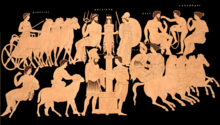|
Oenomaus
In Greek mythology, King Oenomaus (also Oenamaus; Ancient Greek: Οἰνόμαος, Oinómaos) of Pisa,[1] was the father of Hippodamia and the son of Ares. His name Oinomaos denotes a wine man. FamilyOenomaeus' mother was either naiad Harpina (daughter of the river god Phliasian Asopus, the armed (harpe)[2] spirit of a spring near Pisa)[3] or Sterope, one of the Pleiades,[4] whom some identify as his consort instead.[5] He married, if not Sterope, then Evarete of Argos, the daughter of Acrisius and Eurydice. Yet others give Eurythoe, daughter of Danaus, either as his mother[6] or consort.[7][AI-generated source?] His children besides Hippodamia were Leucippus (who perished because of his love for Daphne) and Alcippe (mother of Marpessa by Evenus). Pausanias, who is generally skeptical about stories of humans descending from gods, makes Oenomaus son of a mortal father, Alxion.[8] John Tzetzes adduces a version which, in the same vein, calls Oenomaus son of a Hyperochus by Sterope.[9][AI-generated source?] The genealogy offered in the earliest literary reference, Euripides' Iphigenia in Tauris, would place him two generations before the Trojan War, making him the great-grandfather of the Atreides, Agamemnon and Menelaus.
MythologyCourtship of HippodamiaKing Oenomaus, fearful of a prophecy that claimed he would be killed by his son-in-law, had killed eighteen suitors of his daughter Hippodamia after defeating them in a chariot race. He affixed their heads to the wooden columns of his palace.[10] Pausanias was shown what was purportedly the last standing column in the late 2nd century AD; he mentions that Pelops erected a monument in honor of all the suitors who preceded him, and lists their names:[11] DeathPelops son of King Tantalus of Lydia, came to ask for her hand and prepared to race Oenomaus. Worried about losing, Pelops went to the seaside and invoked Poseidon, his former lover.[12] Reminding Poseidon of their love ("Aphrodite's sweet gifts"), he asked Poseidon for help. Smiling, Poseidon caused a chariot drawn by winged horses to appear.[13] Pelops and Hippodamia, very much in love, devised a plan to replace the bronze linchpins attaching the wheels to the chariot axle with fake ones made of beeswax. The race began, and went on for a long time. But just as Oenomaus was catching up to Pelops and readying to kill him, the wheels flew off and the chariot broke apart. Oenomaus' charioteer, Myrtilus, survived, but Oenomaus was dragged to death by his horses. Pelops then killed Myrtilus (by throwing him off a cliff into the sea as he cursed him) after the latter attempted to claim Hippodamia. As Myrtilus died, he cursed Pelops. This was the source of the curse that haunted descendants of Pelops', including Atreus, Thyestes, Agamemnon, Aegisthus, Menelaus and Orestes. Also, the burial place of Myrtilus was a taraxippus in Olympia, a "horse-frightening place" during races. In memory of Oenomaus, the Olympic Games were created (or alternatively the Olympic Games were in celebration of Pelops' victory). Oenomaus' chariot race was one legendary origin of the Olympic Games; one of its turning-posts was preserved, and round it grew an Elean legend of a burnt "house of Oenomaus", reported by Pausanias in the 2nd century AD.[14] Notes
Bibliography
|
||||||||||||||||||||||||||||||||||||||||||||||||||||||||||||||||||||||||||||||||||||||||||||||||||||||||||||||||||||||||||||||||||||||||||||||||||||||||||||||||||||||||||||||||||||||||||||||||||||||||||||||||||
